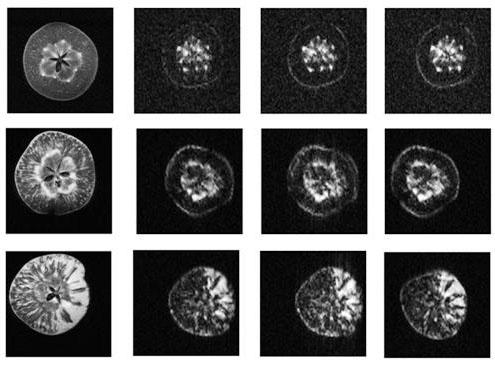
Campus Moncloa
Campus of International Excellence
Magnetic resonance can reveal the inner quality of food
Researchers of UPM have developed a tool that allows researchers to know the microstructural properties of fruit and vegetables. This tool can also improve the process of packaged food.
01/07/2014
A team of the School of Agricultural Engineering from UPM and belonging to the Campus Moncloa: Campus of International Excellence is studying, within the FP7, the physicochemical properties of food using magnetic resonance (MRI). This new technique will allow the food industry to know the water concentration and balance that should be established to preserve horticultural products.

An Apple magnetic resonance imaging
In the wake of a previous study based on technologies such as X-ray computed tomography (X-ray CT), optical coherence tomography (OCT) and nuclear magnetic resonance (NMR), amongst others, the research group LPF-Tagralia of UPM, assigned to the Agri-Food and Health cluster of the Moncloa Campus, has developed a tool to study the microstructure and inner quality of food. They combine techniques of relaxometry with optimizing rapid image sequences. The result is a low cost model, of interest for the industry, which allows the analysis of the product in movement without the need to cut it.
In general, when talking about MRI, the first thing that comes to mind is that images can help doctors to make a diagnosis. However, the MRI techniques and applications are diverse. Ángela Melado Herrero, a researcher of LPF-Tragalia, explained that by through an image created with this technique is possible to see the inner composition of a sample with no need of cutting the product. “Therefore, this technique is neither destructive nor invasive and all this allows us to consume or reuse the product without any problem”. This technique can also obtain 2D and 3D images.
The usage of relaxometry /diffusometry allowed the research team to study the physical properties, such as the presence of pores or the water (vacuole, cytoplasm) of the samples of the cellular compartments. All this gives information about their microstructure. “This study of properties is important when manipulating food, for example, drying / rehydration or freezing, among others. The combination of this technique with the resonance allow researchers to conduct a multiscale study (at macro and microscopic level) which is neither destructive nor invasive for the food”, explained Melado.
To learn more
Tag: Agri-Food and Health Source: UPM
Event date:
01/07/2014
